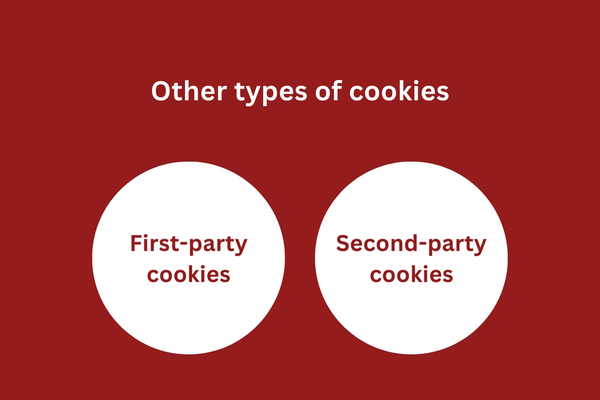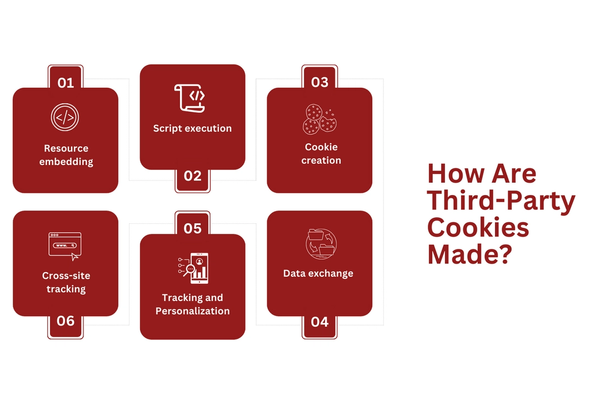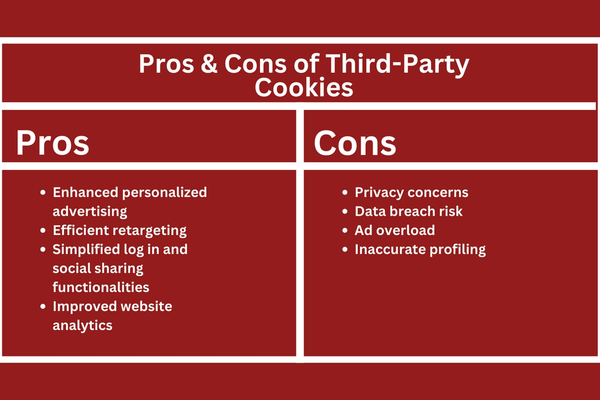
You’ve probably seen the term “Please allow third-party cookies” when you visit a website for the first time.
Often, the message is accompanied by a little cookie emoji and some text, saying, “Hey, don’t mind me; I’m just one of those things you have to consent to!”
But despite its friendly, casual name, third-party cookies are actually quite an important subject to understand. After all, it involves you handing over a lot of your personal information, some of which you might not even know.
So, in this article, we will discuss third-party cookies in more detail, giving you all the information you need.
Let’s dig in.
Key Takeaways
When used correctly, third-party cookies can ensure that users receive a more personalized advertising experience.
Most of the time, users are consenting to third-party cookies without knowing how much personal information they agree to share with companies.
In light of growing user privacy concerns (and to align with updated regulations), browsers are gradually phasing out third-party cookies.
What is a Third-Party Cookie?
What is a Third-Party Cookie.png

Sadly, a third party cookie isn’t quite as tasty as they sound. A third-party cookie is a tracking technology that gathers a user’s browsing history and online activity to better understand your digital footprint.
Alana Gibson, COO at DGR Legal, says:
“Third-party cookies are set by domains other than the one visited, often used for tracking and advertising purposes, facing increasing scrutiny and regulation.”
Maria Chamberlain, the Owner of Acuity Total Solutions, says:
“Third-party cookies are like nosy neighbors, peeking into your online activities to serve targeted ads. Sometimes that’s helpful. Maybe your neighbor tells you about an upcoming event or sale in the neighborhood you wouldn’t otherwise know about. Other times, it’s just creepy how much they know about you.”
So, whyis this information so important? Well, advertisers LOVE it, and they’ll pay top dollar for it, too. Advertisers use that information to present you with personalized ads for a service or product they anticipate you will love based on the user information provided.
For example, suppose you spent the last few days searching for new rugs online. In that case, advertisers will use that information to predict you are probably considering buying a new rug in the not-too-distant future and will send you ads for rugs they think you might like.
Not only that, but they may also presume you are in the market for other soft furnishings, too, as part of a remodeling, and will promote those to you as well.
Other types of cookies
Other types of cookies.png

Third-party cookies aren’t the only player in town. There are also a couple of other forms of cookies on the web to be aware of.
First-party cookies
First-party cookies are the snippets of data you provide to a specific website when you log in and tick the “remember me” button, making it quicker next time.
This information is stored and used solely within that single website, and they do not have permission to share it with any other company.
These are often strictly necessary cookies.
Tip: If you only use strictly necessary cookies, a cookie banner isn’t required by the GDPR
Second-party cookies
Second-party cookies are the least common form, which is where one website creates the cookie and stores your data before sharing it with another website that both the website and the user agree to.
This type of cookie would only normally occur between two websites that have a working relationship or are run by the same overarching company.
How Can I Tell if My Website Uses Third-Party Cookies?
How Can I Tell if My Website Uses Third-Party Cookies.png

Now that we have a better grasp of what third-party cookies are, it’s time to track them down.
The first step is to start by examining your source code on each web page. Search for any snippets of code that make reference to an external domain, as they likely indicate a third-party service on your website.
Don’t worry; you don’t need to be a coding wizard to access the code, simply head to each web page on your site and press CTRL+U at the same time.
As a website owner, it’s crucial that you take this inspection seriously and go through each aspect with a fine-toothed comb. Third parties can get embedded in several ways, some of which may pass under the radar at first glance.
Does your website use third-party cookies? If so, you need to ensure your website is compliant. Get in touch with us for a complimentary consultation to learn what you must do to ensure compliance.
How Are Third-Party Cookies Made?
How Are Third-Party Cookies Made.png

Creating and utilizing third-party cookies that collect user information for third party data involves a multi-step process that occurs behind the scenes, combining various technologies and interactions between websites, browsers, and external domains.
Resource embedding
When a user visits a website, the web page often includes resources like images, videos, advertisements, and tracking scripts from external domains. These external domains are operated by third-party services, such as advertising networks or analytics providers.
Script execution
As the web page loads, the user’s browser executes the scripts embedded within it, including those from third-party domains. These scripts can perform various functions, such as displaying ads, collecting personal data, or tracking user interactions.
Cookie creation
Within these scripts, instructions can be written to create and set cookies on the user’s device. These cookies are associated with the third-party domain, allowing it to store and retrieve information. For instance, an advertising script might set a cookie to track user preferences or record ad interactions.
Data exchange
As the user continues to browse the web, their browser requests the third-party domain each time it encounters a resource linked to that domain. The browser automatically includes any relevant cookies in these requests, allowing the third-party domain to read and update the cookies with new information.
Tracking and Personalization
Over time, the third-party cookies accumulate data about the user’s online behavior and interactions across different websites.
This information is used to create user profiles, which are then leveraged for targeted advertising and personalized content delivery. For example, if a user frequently visits fashion-related sites, third-party cookies can help display fashion-related ads on various websites the user visits.
Cross-site tracking
Third-party cookies enable cross-site tracking, as the same third-party domain is integrated into multiple websites. This allows the third-party service to monitor the user’s activities across these sites and gather a comprehensive view of their interests and preferences.
Examples of Third-Party Cookies
There are many third-party cookies out there, but here are a few of the most common types of cookies that can be found:
Meta (Facebook) Pixel
This third-party cookie enables website owners to track user activity on their site and then retarget those users with relevant ads on Facebook and Instagram based on their behavior.
DoubleClick by Google
This cookie is often used by advertisers to track user interaction with ads and measure the effectiveness of ad campaigns across different websites.
Amazon Associates
This cookie is used by Amazon’s affiliate program to track referrals from partner websites. If a user clicks on an Amazon affiliate link on one site and makes a purchase on Amazon, the affiliate site may earn a commission.
AddThis
This social sharing tool uses third-party cookies to track users’ sharing behavior and provide social media buttons on websites.
Twitter Conversion Tracking
This cookie allows advertisers to track conversions and user interactions that resulted from their Twitter ads.
Pros & Cons of Third-Party Cookies
Pros & Cons of Third-Party Cookies.png

As you can see, the concept of third-party cookies is extremely complex, and as a result, they provide several pros and cons, depending on whether you are the business or the consumer. Here’s an overview of the pros and cons:
Pros of Third-party Cookies
There are several pros to cookie consent for both users and businesses. Let’s have a look at some of them.
Enhanced personalized advertising and content recommendations: While this might frustrate some people, others love that ads can be tailored to their shopping requirements.
Efficient retargeting and conversion optimization: For brands, it is much easier to retarget more precisely with their cookie consent, which in turn can significantly improve conversion optimization. Not only could it lead to more sales, but it may also reduce the cost per sale, as the communications and audience are much more targeted.
Simplified log in and social sharing functionalities across websites: Once you’ve consented to third-party cookies, it is much quicker and easier to log into your chosen website.
Improved website analytics and performance measurement: Alongside improving performance, it is also much easier to track those improvements through website analytics. This allows data teams to see what is working and what isn’t and readjust time and money to ensure your marketing is as efficient and effective as possible.
Cons of Third-party Cookies
It’s not all sunshine and rainbows with third-party cookies! There are also some significant cons to consenting to third-party cookies.
Privacy concerns: One of the main concerns that users have about cookie consent is how much data companies glean from it and the intrusive tracking that seems to come afterward. Often, people are unaware of just how much data they have shared, and this can lead to concerns over who has the information.
Data breach risk: By sharing your data, you also leave yourself open to potential cyberattacks or unauthorized access. While certainly not guaranteed when you consent, the more you consent, the more likely it is to occur.
Ad overload: Third-party cookies can lead to an overload of ads that users find annoying and intrusive. Users may be exposed to irrelevant or inappropriate targeted content based on their browsing habits, creating frustration and a negative customer experience.
Inaccurate profiling: Even worse than personalized ad overload is ad overload on the content you don’t resonate with at all. That’s what can happen when the company you consent to has a limited understanding of your preferences or user intent.
How to Legally Use Third-Party Cookies
If you’ve gone through the list of pros and cons for third-party cookies and you’re still interested in this option, we should probably look at how to implement them in a manner that is legal and effective. Here’s how to keep things legal:
Cookie Banner
Users should be informed of the presence and use of tracking cookies. They must accept/opt-in to first party as well as third-party cookies by clicking “Accept All” on your website’s cookie banner that clearly states:
What kind of cookies you’re using
How you use the collected data
A link to your cookie policy (which should be written in plain language)
Read: Cookie Consent Design: How to Design an Effective Banner?
Cookie Policy
First and foremost, you must provide a clear, detailed cookies policy explaining how you plan to use data and which parties you plan to share it with.
Not all of this information needs to be on the original pop-up notification (otherwise, it would fill the screen), but you do need to create a location where this information is easy to access should a user want further clarity or understanding on the matter.
Purpose Limitation
Alongside clarity over what data you are collecting, you also need to ensure your policy includes how you intend to use that data. Are you selling it to a competitor? Are you using it across another of your businesses? This is all data your users need to be able to access if they want to.
Data Minimization
This is one of the GDPR principles. Once you’ve laid out the purpose of your data collection, stick to it. If you plan to use their email address and name for a given reason, don’t also collect additional information that you don’t need, as this may raise issues with the legality of your process.
User Control
Speaking of users, you also need to ensure they still have control of their data, even after consenting to let you collect it. Offer the ability to manage what data they share, such as opting in or out of tracking or disabling it altogether.
Regular Review
As with any legal requirement, things change as new cookie laws are introduced, so periodically assessing your policy and updating it to meet new requirements is crucial. Keep documentation of your current policy for clarity and in case you are ever required to share this information for legal reasons.
FAQs
Is it safe to allow third-party cookies?
Allowing third-party cookies isn’t necessarily unsafe, but it does raise potential privacy concerns. Third-party cookies are often used for online advertising and behavioral tracking across multiple websites, which can result in a loss of privacy as your browsing habits could be tracked and analyzed by various companies without you knowing who has access to that information.
It’s recommended to regularly clear these types of cookies from your browser or set preferences within the browser settings depending on individual comfort levels with data sharing. Alternatively, you may opt to block third party cookies altogether using a browser like Safari or Firefox.
Learn if it’s safe to allow first party cookies in this article.
Why is Google getting rid of third-party cookies?
Google Chrome has decided to phase out third-party cookies in its Chrome browser as part of its initiative to create a more privacy-focused web environment. This change came about due to increasing concerns from users and regulators around the globe regarding data privacy issues associated with these types of cookies, including non-consensual tracking and personal information sharing among companies for advertising purposes. Google’s move aims to boost user trust while enabling online businesses to thrive through alternative, less invasive, yet effective solutions.
Learn about all the different types of cookies in the cookie category of our website.
How do third-party cookies differ from first-party cookies?
Third-party cookies track users across different websites, while first-party cookies are specific to the website being visited.
Discover the best cookie consent solution on the market here
How have the practices and significance of third-party cookies evolved?
Here’s how third party cookies have evolved over the recent couple of years:
Privacy concerns led to increased scrutiny.
Regulatory changes imposed stricter limitations.
Shift towards user-centric data protection.
Rise of alternatives for targeted advertising.
Emphasis on consent-based tracking methods.
Learn what the cookie consent requirements are for your business here
Can you explain the concept of cross-site tracking facilitated by third-party cookies?
Cross-site tracking through third-party cookies involves monitoring a user’s online activity across various websites to gather behavioral data and create personalized profiles for targeted advertising.
Find out all the cookie consent best practices here
What alternatives are emerging to replace third-party cookies?
Alternatives include contextual advertising, first-party data utilization, and AI-driven insights.
Contact us today if you want to learn how to ensure your website stays compliant
How do website operators utilize third-party cookies?
Website operators use third-party cookies to track user activity across different sites, enabling data collection for targeted advertising and user behavior analysis.
Here are the best compliance services on the market
How Can Captain Compliance Help?
If you want to use cookies on your website, you must ensure there is a clear and detailed cookie policy, that the data collected is relevant to what was agreed upon by consenting users, and that users have control over what type of data they share.
At Captain Compliance, we can help you ensure your customer’s privacy is protected online, keeping them safe and secure, and you are legally compliant.
Contact us today for a free consultation to learn what you have to do to ensure compliance.